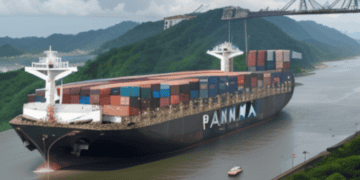The Panama Canal, a crucial shipping route connecting the Atlantic and Pacific oceans, is facing significant congestion due to a backlog of ships. In late August, approximately 135 vessels were waiting to pass through the 82-kilometer waterway, a 50% increase from the typical number. This bottleneck impacts a wide range of goods, including Ecuadorian bananas bound for Florida, Chilean poultry heading to northern Europe, US liquid natural gas (LNG) to Asia, and various products from China.
A prolonged drought has reduced water levels in the canal, necessitating a decrease in the number of ships that can traverse its locks. Consequently, large container ships and tankers carrying diverse cargoes, from perishable items to energy resources, are experiencing delays.
The severity of the impact varies depending on the type of cargo and destination. For instance, the shipping of bananas from Ecuador to Florida is critically affected as the Panama Canal is the primary route for this trade. For LNG shipments from the US to Asia, alternate routes like the Suez Canal are available but are more time-consuming and costly. This situation is particularly problematic for perishable goods in refrigerated containers, as delays can lead to spoilage.
The canal relies on rainwater for its operation, specifically for raising and lowering ships in its locks. However, increasing demands for water from the growing Panamanian population, agriculture, and water-intensive industries, combined with more frequent droughts due to climate change, have strained water availability. Panama Canal authorities have implemented water-saving measures and reduced the allowable weight for ships passing through, expecting these restrictions to last for about ten months.
The current backlog at the Panama Canal is raising concerns, especially in light of the recent global supply chain disruptions experienced during the pandemic. This situation is prompting businesses to consider “nearshoring” – relocating operations closer to their target markets to mitigate risks associated with extended supply chains and environmental factors.
As companies and consumers grapple with the implications of the Panama Canal congestion, the situation highlights the vulnerability and interconnectedness of the global supply chain.
Stay current with supply chain report news at The Supply Chain Report. For international trade tools, see ADAMftd.com.
#PanamaCanalCongestion #GlobalShippingDelays #PanamaCanalDrought #SupplyChainDisruptions #LNGShipping #EcuadorBananas #ChilePoultryExports #ClimateImpactShipping #NearshoringTrends #GlobalTradeRoutes #PerishableGoodsLogistics #RainwaterDependency #PanamaCanalBacklog

















